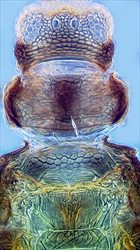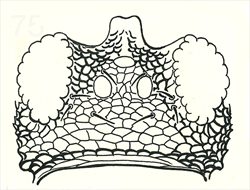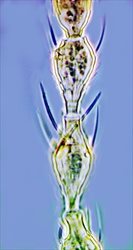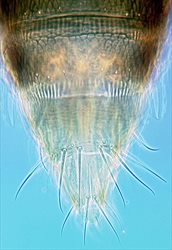
Female

Head & thorax

Head

Metathoracic furca

Antennal segments IV-V

Tergites VII-X

Fore wing

Hind tibia & tarsus
Both sexes fully winged. Body brown, head yellow at anterior; legs yellow, mid and hind femora brown; III–V largely yellow; fore wing with extensive pale area medially between two darker bands. Antennae 8-segmented, VIII more than twice as long as VII; III and IV each with forked sense cone extending well beyond apex of segment. Head reticulate with transverse occipital ridge; ocellar setae III on anterior margins of triangle; three pairs of postocular setae present. Pronotum with no long setae. Metanotum reticulate medially, median setae arise medially; metathoracic furca long and U-shaped. Tarsi all 2-segmented. Fore wing with two complete rows of setae, posteromarginal cilia wavy. Abdominal tergites weakly reticulate medially, median pair of setae small; posterior margins without a craspedum, VIII with comb of microtrichia laterally; tergite X with longitudinal split almost complete.
Male sternites III–VII with very small slender transverse pore plate.
Nine species are recognized in the genus Hercinothrips, all of them originally from Africa. Two species, H. bicinctus and H. femoralis, are now widespread around the world. A third species, H. dimidiatus, was found in Portugal in 2015 causing damage to cultivated Aloe arborescens (Mateus et al., 2015), and subsequently found under glass in the Netherlands on A. vera. H. bicintus is very similar to H. femoralis, but has the fore wings more extensively pale medially. Hercinothrips species are unusual amongst Panchaetothripinae in having 2-segmented tarsi, and the fore wing with both longitudinal veins bearing a complete row of setae.
Breeding and pupating on leaves, this species attacks many different and unrelated ornamental plant species in greenhouses in temperate regions. It is sometimes known as the Banana Silvering Thrips, because of the feeding damage to banana leaves and fruits.
Originally from Africa, this species has been recorded only rarely in Britain, always under glass. Since Collins (2010a) noted that the historic record was one of isolated introductions without establishment, there have been several recent findings in England of breeding populations in heated glasshouses housing biological collections. There are also records from a few Western European countries (zur Strassen, 2003); this species is widespread around the world in tropical and subtropical areas.
THRIPIDAE - PANCHAETOTHRIPINAE
Hercinothrips bicinctus (Bagnall)
Heliothrips bicinctus Bagnall, 1919: 258
Heliothrips bifasciipennis Girault, 1926: 1
Collins DW (2010a) Thysanoptera of Great Britain: a revised and updated checklist. Zootaxa 2412: 21–41.
Mateus C, Franco JC, Caetano MF, Borges da Silva E, Ramos AP, Figueiredo E & Mound L (2015) Hercinothrips dimidiatus Hood (Thysanoptera: Thripidae), a new pest of Aloe arborescens in Europe. Phytoparasitica 43 (5): 689–692.
zur Strassen R (2003) Die terebranten Thysanopteren Europas und des Mittelmeer-Gebietes. Die Tierwelt Deutschlands 74: 1–271.